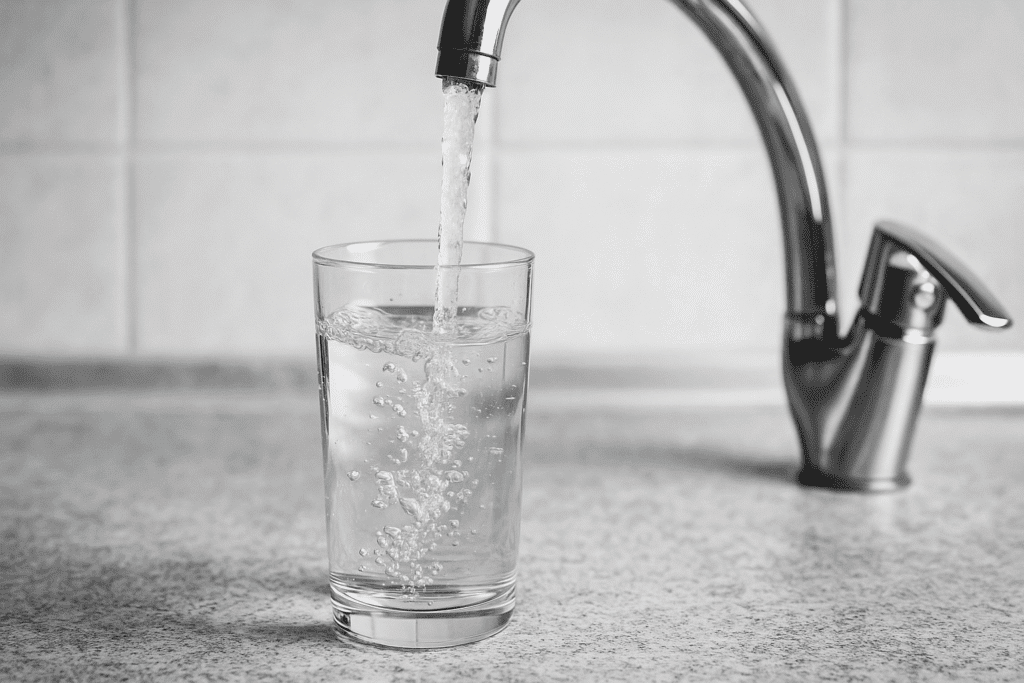Think tap water is safe? Think again. Here’s what might be lurking in your glass—and how it could be affecting your hormones, gut, and long-term health.
We’re told it’s safe. We drink it, cook with it, bathe in it—without a second thought. But what if your tap water isn’t as clean as you’ve been led to believe?
I’m not trying to scare anyone. But the truth is, more and more research (and real-world testing) shows that municipal water might be delivering more than just H₂O. Think: chemicals, pharmaceuticals, chlorine, heavy metals, and hormone-disrupting compounds.
Let’s break it down.

1. Pharmaceutical Residues in Tap Water
It sounds like a conspiracy theory—until you realize it’s been quietly acknowledged for years.
Trace amounts of medications like antidepressants, birth control, antibiotics, and painkillers have been found in tap water across the U.S. (1). While each dose is small, it’s the chronic exposure that’s concerning—especially for children, pregnant women, and people with hormonal imbalances.
Your liver isn’t designed to filter out leftover Prozac from last week’s tap water.
2. Chlorine, Chloramines & Gut Health
Water treatment plants add chlorine (and sometimes chloramines) to kill bacteria—and yes, that’s important. But these disinfectants don’t disappear after they’ve done their job.
They:
- Disrupt gut microbiota (2)
- Can form carcinogenic byproducts like trihalomethanes (THMs)
- May increase oxidative stress in the body over time
So while they protect you from E. coli, they may be creating a whole new set of problems inside your body.
3. Fluoride: Tooth Protector or Endocrine Disruptor?
Fluoride has been added to tap water since the 1940s to prevent cavities—but the science has shifted. Newer research links chronic fluoride exposure to:
- Thyroid dysfunction
- Lowered IQ in children (3)
- Hormonal disruption and even bone density changes
Most countries in Europe don’t fluoridate their water—and they’re not drowning in cavities either. It’s time to ask: are the risks worth it?
4. Microplastics and PFAS (“Forever Chemicals”)
Here’s a scary stat: More than 200 million Americans may be drinking water contaminated with PFAS—chemicals linked to cancer, hormone issues, and fertility problems (4).
PFAS (per- and polyfluoroalkyl substances) are:
- Found in nonstick cookware, takeout containers, and even waterproof clothing
- Extremely hard to break down (they stick around for decades)
- Now found in rainwater globally—even in remote areas
And yes, they’re showing up in tap water all over the country.
So, What Can You Actually Do?
This isn’t about panic. It’s about being proactive. Here’s where to start:
– Filter your water
- Use a high-quality filter that removes fluoride, chlorine, pharmaceuticals, and PFAS. Brands like Berkey, Clearly Filtered, or Aquasana go beyond basic Brita-level filtering.
- Reverse osmosis systems are even more thorough—but may require re-mineralizing afterward.
– Test your water
- You can order at-home tests or check your local water report (available via your city’s water utility or EWG’s Tap Water Database).
– Be mindful of shower/bath exposure
- Your skin absorbs chlorine and other chemicals too. A simple shower filter can make a big difference.
Don’t Trust the Tap by Default
Just because it’s clear doesn’t mean it’s clean. Tap water may not cause an overnight illness—but it’s the slow, steady accumulation of toxins that wears down your immune system, gut, and hormones over time.
Clean water isn’t a luxury—it’s a baseline. It’s one of the simplest, most overlooked upgrades you can make for your long-term health.
SOURCES:
- U.S. Geological Survey (2019). Pharmaceuticals in US Tap Water
- Ghanbari, R., et al. (2016). Effect of Chlorine on Gut Microbiota
- Grandjean, P., et al. (2012). Fluoride and Neurodevelopment
- Environmental Working Group (2022). PFAS in U.S. Drinking Water
Leave a Reply